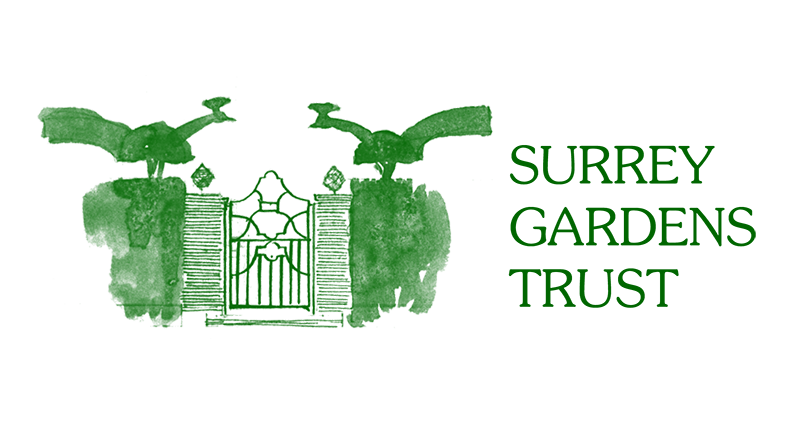Painshill: The Glorious Landscape Created by Charles Hamilton
Written by Gail Sperrin
Painshill Park Photo Credit: Sheri Sticpewich
On a glorious warm late spring day we enjoyed a unique and very special tour of Painshill, one of the finest English landscape gardens in the world.
Karen Bridgman discussing Charles Hamilton’s quest for North American plants. Photo credit: S. Sticpewich
We started in the Walled Garden with Karen Bridgman, who first explained the significance today of Painshill. Having fallen into ruin and decay since WW2, the restoration which started in the 1980s marked the first major reinstatement of a historic landscape in the UK. The Painshill Park Trust was formed in 1981 and embarked on an enormously ambitious project, to rescue a site so derelict that it was almost at the point of no return and put the landscape and all its buildings back to its 18th-century heyday. Today Painshill is a Grade I listed landscape and of great international importance.
Painshill was the creation of Charles Hamilton between 1738 and 1773. To understand his inspiration and vision we were transported back to the eighteenth century to learn how he was influenced by his two Grand Tours across Europe and by his love of art and plants, to create living paintings in the landscape. He was keen to acquire the exotic plants newly available from the American colonies for his landscape. We heard how eighteenth-century businessman Peter Collinson developed a partnership with John Bartram, a botanist, horticulturist, and explorer, based in Philadelphia. Bartram collected and packed seeds in special boxes for transport, to be propagated in England for the first time. "Bartram's Boxes", as they became known, were shipped regularly to Peter Collinson every autumn for distribution in England to a wide list of clients, including Hamillton. The boxes generally contained 100 or more varieties of seeds, and sometimes included dried plant specimens and natural history curiosities as well. Among these exotics were many flowering shrubs and trees including Wisteria, magnolia, rhododendron, and the tulip tree. The three men shared a passion for plants, but it was the alchemy between Hamilton’s creative genius, Collinson’s entrepreneurial drive and Bartram’s spirit of adventure that made this such an extraordinary landscape. Painshill is now home to Plant Heritage’s John Bartram Heritage Collection of American woody species representing the contents of these seed boxes.
Then we enjoyed a fascinating walking tour of the park with the Head Gardener Jake Lovick. As well as leading us on an exploration of the work of art that is Painshill, Jake also gave us insights into the issues that must be addressed and the compromises that must be made when managing an historic landscape in today’s climate. We saw the ancient sweet chestnut coppice now carpeted with bluebells, the vineyard, the gothic temple, bridges, lawns, lakes, the grotto, and the Georgian waterwheel. We enjoyed views, vistas and different scenes intended to evoke a range of emotions using elements of surprise, variety, and concealment. Finally arriving at the Temple of Bacchus a delicious spread was laid out for our lunch in front of the sweeping views over the landscape towards the North Downs. Jake’s highly informative commentary and Karen’s historic books and other materials gave us some idea of the knowledge, skill, and dedication that has been required from staff and volunteers to restore, manage, and ensure the survival of Painshill for future generations to enjoy.
Cherrill Sands gave a short talk about William Gilpin, and there was time afterwards for individual exploration to the gothic tower, the hidden hermitage, and the Turkish tent.
It is reassuring to know that this extraordinary landscape is in the capable hands of the passionate, knowledgeable, skilled, and enthusiastic staff and volunteers who looked after us so well throughout our visit. This was indeed a unique and very special day!








